Explainer videos are very popular, and there’s a good reason why. These videos help businesses explain their products and services, which makes it easier for their customers and business partners to make informed decisions.
Do you need to create an explainer video? Here’s a guide to help you create a good explainer video!
What’s an explainer video?
Explainer videos are short animated pieces that empower businesses to tell stories about their brands, products, or services in an engaging, clear way.
In terms of key conventions, these videos are characterized by simple graphics and very clear language. This approach helps businesses communicate the mechanics and benefits of complex products and services in a very clear way. Without them, many businesses would struggle.
Studies demonstrate that video has the potential to increase engagement and facilitate the retention of knowledge, which makes explainer videos a particularly important way to succinctly impart information.
These videos first emerged around 2010, when internet speeds started facilitating hassle-free video streaming. At that time, pioneering businesses such as Twitter capitalized on this format to introduce their potential users to their platforms.
Since then, explainer videos have become varied in strength, in terms of popularity. They’re also more useful than ever before, given the dwindling attention spans of internet users and the ravenous appetite for video content.
Explainer videos are now essential tools in the arsenal of every marketing manager. As a project manager, you may have traced the growth of these videos over the years. But how are common explainer videos made?
How to make an explainer video
The secret of creating a perfect explainer video is planning—and lots of it. To create a video that radiates quality and engages viewers, every element must come together in perfect harmony.
When it comes to this type of video, a project manager can really make a difference. Here’s a closer look at what the five stages of the creation process entails. Bear in mind that this outline is general, as these stages vary from one project to the next.
1. Rigorous planning and concepting
The success of your explainer video hinges on quality planning. Given that there will be a lot of dependencies and interlinked tasks, your team must collaborate without rushing or falling behind. In other words, you should create a detailed scope statement, a clear project outline, and a robust timeline for your project.
These tools will help your team work together harmoniously.
At this stage, you’ll want to have an idea of the concept. Think about it, are you looking to create live action explainer videos or whiteboard animation? Whatever you choose, having a rough idea of the concept will help you accurately outline your needs, in terms of resources and team members.
2. Scripting and storyboarding
Once you’re equipped with project management tools and a strong concept, it’s time to start scripting and storyboarding. Some project managers prefer for the script to take the lead, but it’s often best to simultaneously approach these tasks.
While this process can be very complex, the best explainer videos combine a clear script and stunning visuals that complement and enforce one another. The best way to create this relationship is by placing an early focus on blending the two.
At this stage, ideas are key. You should feel free to take the script and storyboards through multiple drafts, which will really refine the idea and get the best possible drafts ready for production.
3. Voice-over recordings
At this point, some project managers prefer to move onto the illustration and animation phase, but it often makes sense to tackle voice-overs recordings after the scripts and storyboards are in place.
There are two main reasons for this tactic:
- Having a finalized voice-over helps your animators and sound designers understand the pacing and speed of the video. Then they won’t have to make adjustments to their work to accommodate for the voice-over.
- A voice-over really helps bring a great explainer video together. Viewers relate most closely with the voices , so it has to be perfect to drive home key messages. If the voice-over is an afterthought, it will become ineffective.
4. Music, illustration, and animation
Now that everything is in place, it’s time to think about the music that will accompany your explainer video. This tactic will help set the tone and give your animators cues for on-screen action.
Once a track is in place, you can let your talented designers and animators work their magic. Their work will be dictated by the voice-over and music track you selected. The detailed storyboards also help your team produce accurate work the first time around.
At this stage, you should use a video commenting and annotation tool to collect feedback on your video. This will help you get the story just right before adding the finishing touches.
5. Sound design
Finally, your sound engineers should be called on to add any necessary sound effects or other touches. This step can really bring an explainer video together and make it believable. (We’ll l cover some examples of this step a little later.)
The work should be precise, so your sound designers will be happy to add a layer on top of an almost-finished product that has all the timings set. Before you publish your video, we recommend to share it with some colleagues for a final check. A video collaboration software will make this step a breeze.
Explainer video pricing
Explainer videos are short, but they can still cost a lot to produce. In fact, the costs can come as a surprise to those outside the world of marketing.
Most agencies charge per minute of video, but this protocol can vary according to the type of video that’s requested and other external factors.
It can cost anywhere from $5,000 to $35,000 to create one minute of a quality explainer video. While this range may sound exorbitant, here are some of the tasks that must be performed to create an effective explainer video:
- Scripting
- Storyboarding
- Illustration and animation
- Sound design
- Voice-over recording
- Project management
To get the best results and create a show-stopping explainer video, each step must be perfectly executed. For example, animation can make or break an explainer video.
Nine explainer video templates
Templates can help your team hit the ground running and produce quality work in the most efficient time frame possible. Here’s a closer look at templates that can help you produce the best explainer videos.
Here are four common types of explainer videos:
1. Product explainer videos
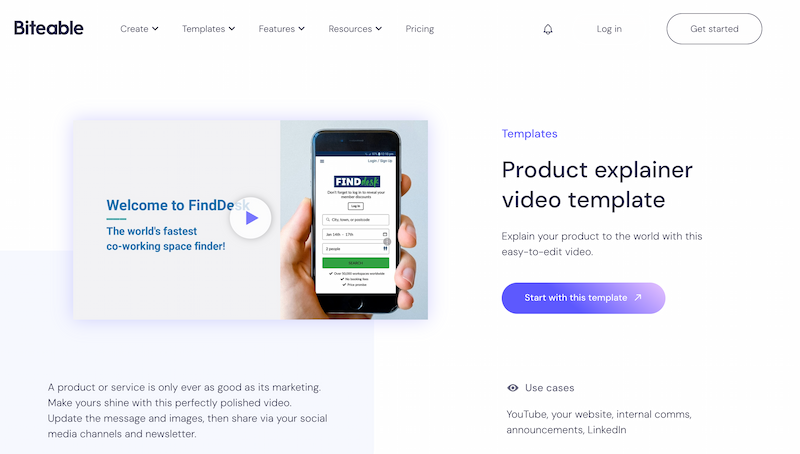
Biteable offers its visitors a wide range of templates for creating a brand new explainer video. The in-browser service is free, which makes it simple to edit templates that have unique pictures and text.
The tool is fun to play around with. Even if it’s not used to create a final explainer video, it’s an effective tool for creating a proof of concept. This template for explainer videos makes it easy to create a smooth, modern video that’s easy to understand.
2. Animated explainer video
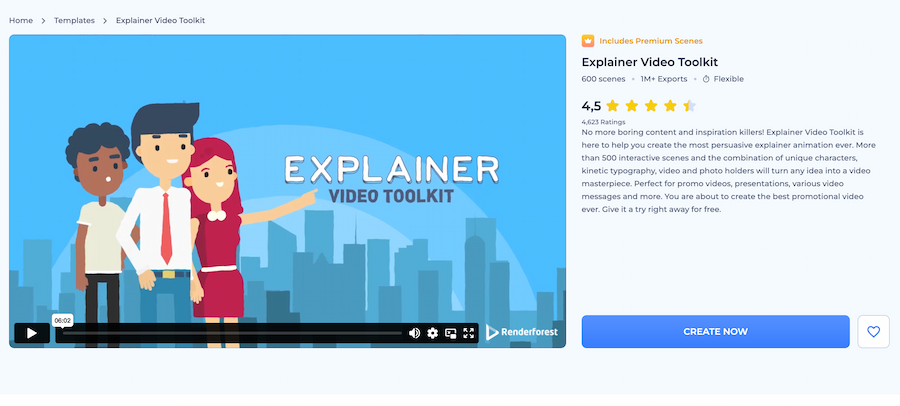
To empower its users to create an animated explainer video, Renderforest offers an Explainer Video Toolkit. The tool offers over 500 interactive scenes and a vast combination of characters, videos, photo holders, and kinetic photography to cover your entire video.
This process is simple, and it can be used to create a detailed proof of concept or even a finalized explainer video. It’s impressive to see what videographers have achieved by using this tool, and you can get a lot of inspiration for your own animated video by watching the templates.
3. App explainer videos
Biteable offers a clear template for explainer videos that can be used to guide viewers through the process of creating a new app. While these apps can sometimes be confusing, their value proposition isn’t immediately clear. So these explainer videos have to be effective!
This template is attractive and modern, which helps businesses clearly articulate the value proposition of an application and shows them exactly how it looks and operates. The minimal design style uses a few nice visual effects, which shows that less really can be more.
4. Whiteboard explainer videos
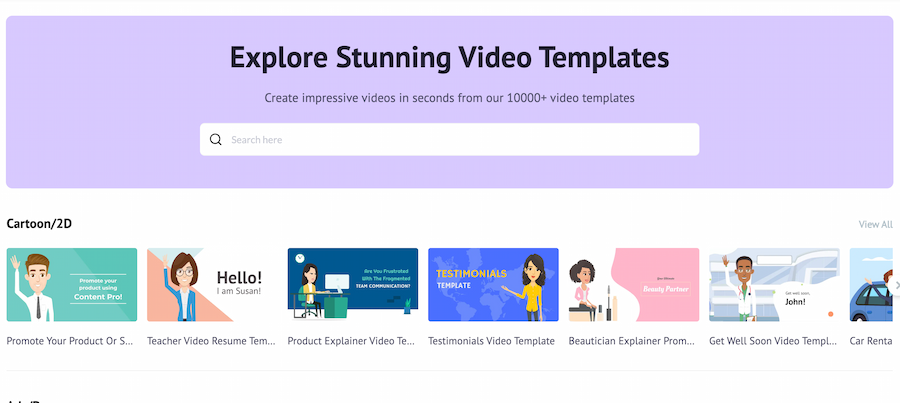
Animaker offers a wide range of video templates to help its users create videos within minutes. There are lots of templates to choose from. One key option is a template for whiteboard videos.
By now, these videos may feel a little dated, but they’re still very popular. As the action unfolds before viewers, they’re drawn in, which allows you to effectively deliver your messages. The combination of handwritten text and a voice-over can also create a really personable experience.
5. Cartoon explainer video
Once again, Animaker offers some really great templates for animated explainer videos. Their style is fun and quirky, which helps businesses present their products or services to viewers in an engaging, approachable way.
The colors are stylish, and the music fits the tone. These features show the ways various elements can come together to become greater than the sum of their parts. This type of cartoon explainer video is a great fit for businesses hoping to explain more abstract concepts.
6. Template for explainer video scripts

Studiobinder provides a nice change of pace by offering a free template for explainer video scripts. To make an effective explainer video, this document helps you focus your script and hit all the key points along the way.
The document covers time codes, too, which helps users consider the timing and cadence of the explainer video. When it comes to creating an effective explainer video, scripts are often overlooked, which will really help your team focus and give your video the attention it deserves.
7. 2D explainer video
With this template for 2D explainer videos, Animaker shows us that explainer videos don’t have to be all about flashy animation and cutting-edge graphics. This video is fun and vibrant, and it drives home key information while it energizes the viewer.
This 2D option is great for transmitting important graphics and texts to the viewer. The simple color palette keeps things consistent and clean. So it’s easy to adapt the template to your client’s brand guidelines.
8. Website explainer videos
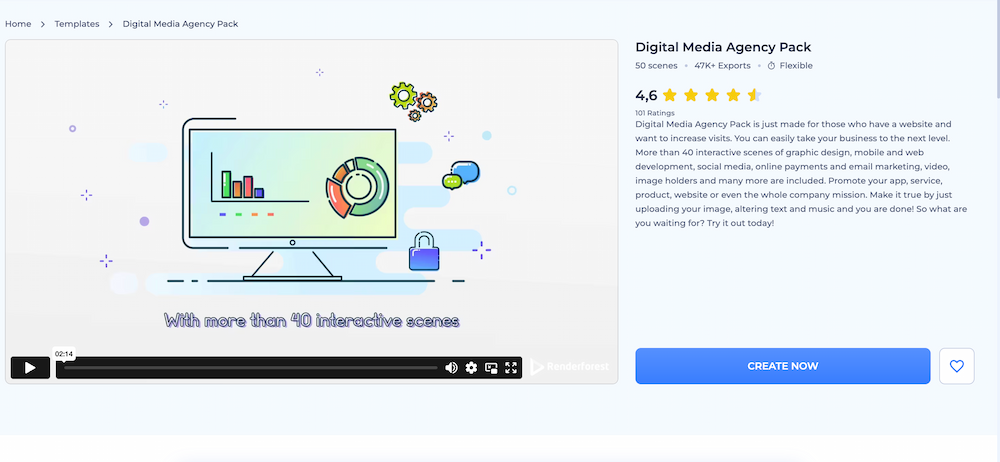
Renderforest offers this template for online explainer videos, which will help users increase visits to their website. It offers more than 40 interactive scenes, which makes it easy to promote an app, service, product, website, or even an entire company.
Since this template is highly customizable, you can experiment with the various scenes and assets, which is a great way to get your creative juices flowing! Even If you don’t use the final video, this tool is a great way to create a proof of concept and get some fresh ideas.
9. Explainer videos for startups
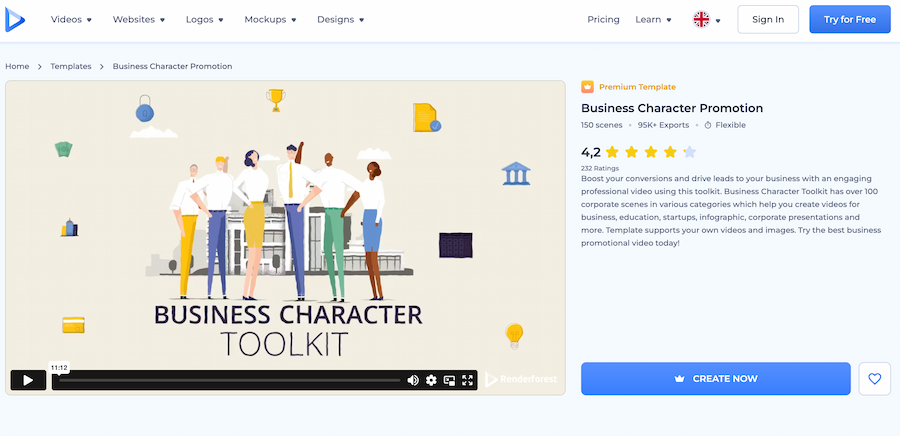
Renderforest also offers a template for startup explainer videos. This tool is perfect for startups looking to quickly share their new businesses and innovative products. Since this tool is often complex, an explainer video can help make things as clear as possible.
As with other Renderforest templates, it offers an impressive range of assets. Users will find over 100 corporate scenes that make it easy to create videos for a wide range of purposes, including corporate and academic presentations.
Four explainer video examples
We bet you’re thrilled to start imagining the kinds of videos you can create in the future. Ready to see how all of the above steps come together?
Here’s a look at some of the great explainer video examples:
1. Mint
Mint helps its users manage their money and keep track of their finances. For many people, finances are a delicate and personal topic, so this explainer video creates a trustworthy feel.
This explainer video achieves this goal by foregrounding the viewers’ pain points and underscoring just how difficult it can be to track finances. The rest of the video is then dedicated to addressing how Mint can fix those pain points.
This structure is effective, and it helps contextualize the entire explainer video. While this video is heavy on information, it effectively uses graphics and holds the viewer’s interest.
2. Dropbox
Dropbox has cemented itself as a key player in the competitive landscape of cloud storage. The company now has over 500 million users, who store over 1.2 billion files! While the architecture is complex, this excellent explainer video keeps things simple.
This video does a fantastic job of explaining how to use this platform.
The sketches are fun, and the voice-over is light, which gives the platform a lighthearted air.
3. Filestage
We’re very proud of our very own explainer video! This example combines film footage and screen captures, helps set the scene, and shows viewers exactly how the tool works in context.
Given that this explainer video is focused on our product, it was important for us to really showcase how the platform looks and feels.
Our team did a great job at capturing and articulating the awesome power of the Filestage platform, including how it can help creative teams take their review and approval processes to the next level.
4. Bitcoin
Even though bitcoin is so prevalent in contemporary commerce, many people still don’t fully understand it. In the above example, The Guardian aims at bridging this gap or offering a definitive overview of exactly what bitcoin is and how it works.
This overview is authoritative, which is achieved through a friendly and expressive voice-over that’s paired with simple animation and an intriguing visual style. This video is also a great example of a whiteboard video.
This video also parts with convention, in terms of its length. Most explainer videos are short and snappy. But given that this video aims at educating its viewers, it’s much longer.
Explainer video software
To get the best results, your team needs the right tools for the job. Here’s a closer look at some of the best explainer video software out there:
1. Vyond
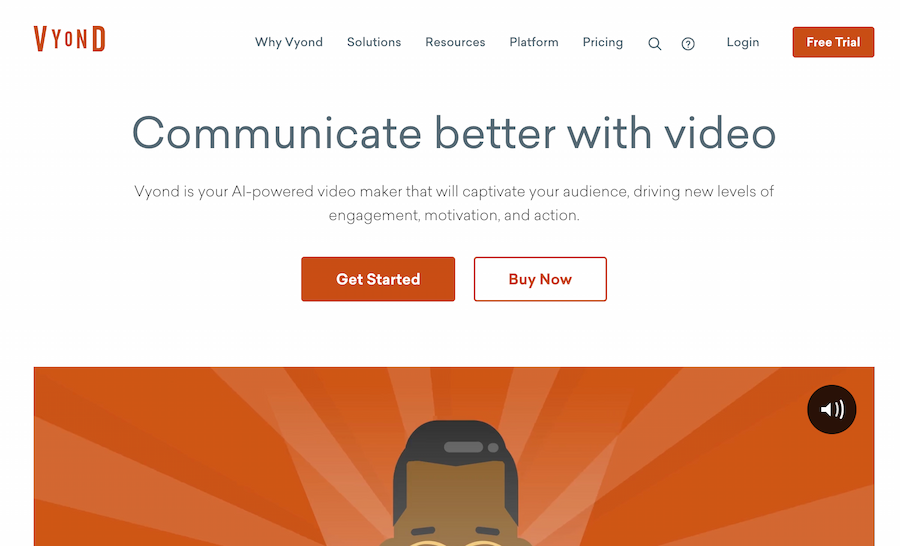
Vyond helps marketing professionals create media that moves. By opening up access to amazing video creations, this tool aims at changing the way the world communicates, one video at a time.
It’s going well, too. To date, over 12 million users have created more than 22 million videos. What are the secrets behind the success of the platform?
Well, this platform offers a large library of templates that its users can leverage in their own videos. In terms of a target audience, it’s aimed at everyone from small business owners to consultants and academics.
The tool places a strong emphasis on usability and simplicity, so it really can help the average person create something special! This platform offers users a free trial, so there’s nothing to lose in terms of understanding the tool.
2. Powtoon

Powtoon empowers marketing professionals to make videos in minutes. By utilizing the quick and easy tools that are on offer, users have created almost 68,000,000 videos and presentations.
Large companies like eBay and Coca-Cola have used the platform to captivate and engage their audience and transmit their key messages. In addition to marketers, students and laymen can also utilize this platform to create impressive presentations and videos.
The platform boasts that it can help its users achieve professional-looking results within just 20 minutes by using a range of ready-made templates. It’s also possible to create a free account without having to provide a credit card. So if you think this platform may be right for you it’s worth experimenting and taking the time to fully grasp the platform.
3. Animaker
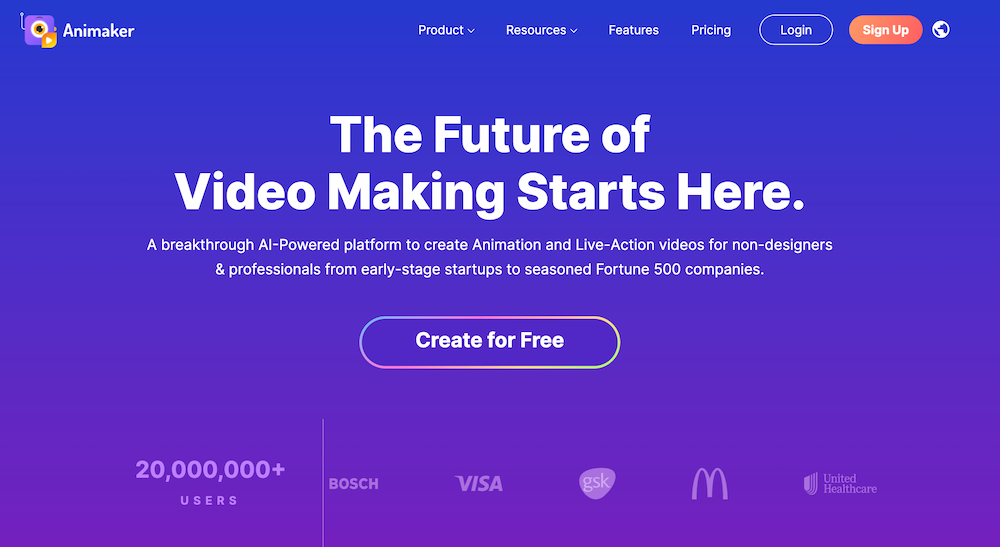
Founded in 2014, Animaker helps companies leverage their internal creativity and satisfy the growing demand for visual marketing.
The company was founded on the premise that creating visual content in-house can be very expensive and time-consuming. This platform aims at solving these problems by offering effective tools that can help the average employee unlock their creativity and knowledge.
By putting the creative keys in the hands of internal experts, this tool aims at making the creative process more effective. Animaker offers a wide range of templates, and the product itself has gathered many favorable reviews.
There’s also an option for a free account, so there’s really nothing to lose by trying out the platform and seeing how it feels. Even if the tool isn’t capable of producing a final video, it can be used to produce early drafts and proofs of concept.
4. Adobe Animate
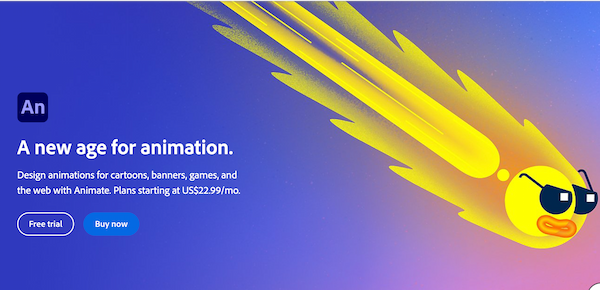
Adobe Animate aims at ushering in a new age of animation. This tool makes it possible to design interactive vector and bitmap animations for a range of marketing collateral. These features make it simpler and faster to reach viewers on a range of devices.
As part of the Adobe suite, this tool is specialized, but it can really power-up the productivity and quality of your in-house animators. With this tool, users will be able to create truly staggering environments and vibrant characters.
This type of tool may be a step above the average explainer video, but it could be used to create something really special. The tool also comes as part of Adobe’s Creative Suite, so if your team already has subscriptions, it could be interesting to experiment with it.
Conclusion
Explainer videos can be very fun to create, and they can really drive value to businesses. We hope this closer look helps you confidently lead your next explainer video project and get the best results possible for everyone involved! If you are interested in how to collaborate and share these videos online then you should try Filestage.





